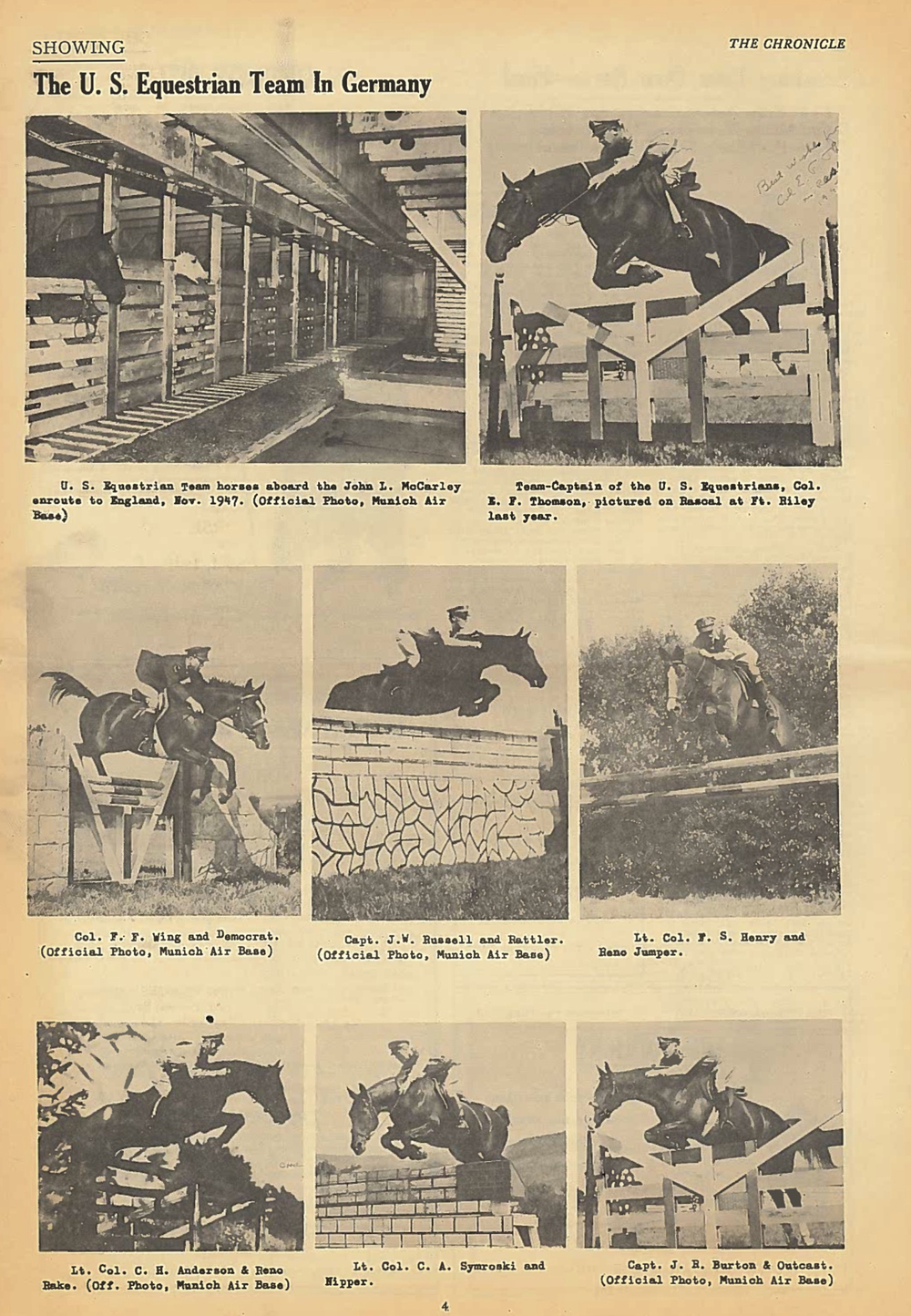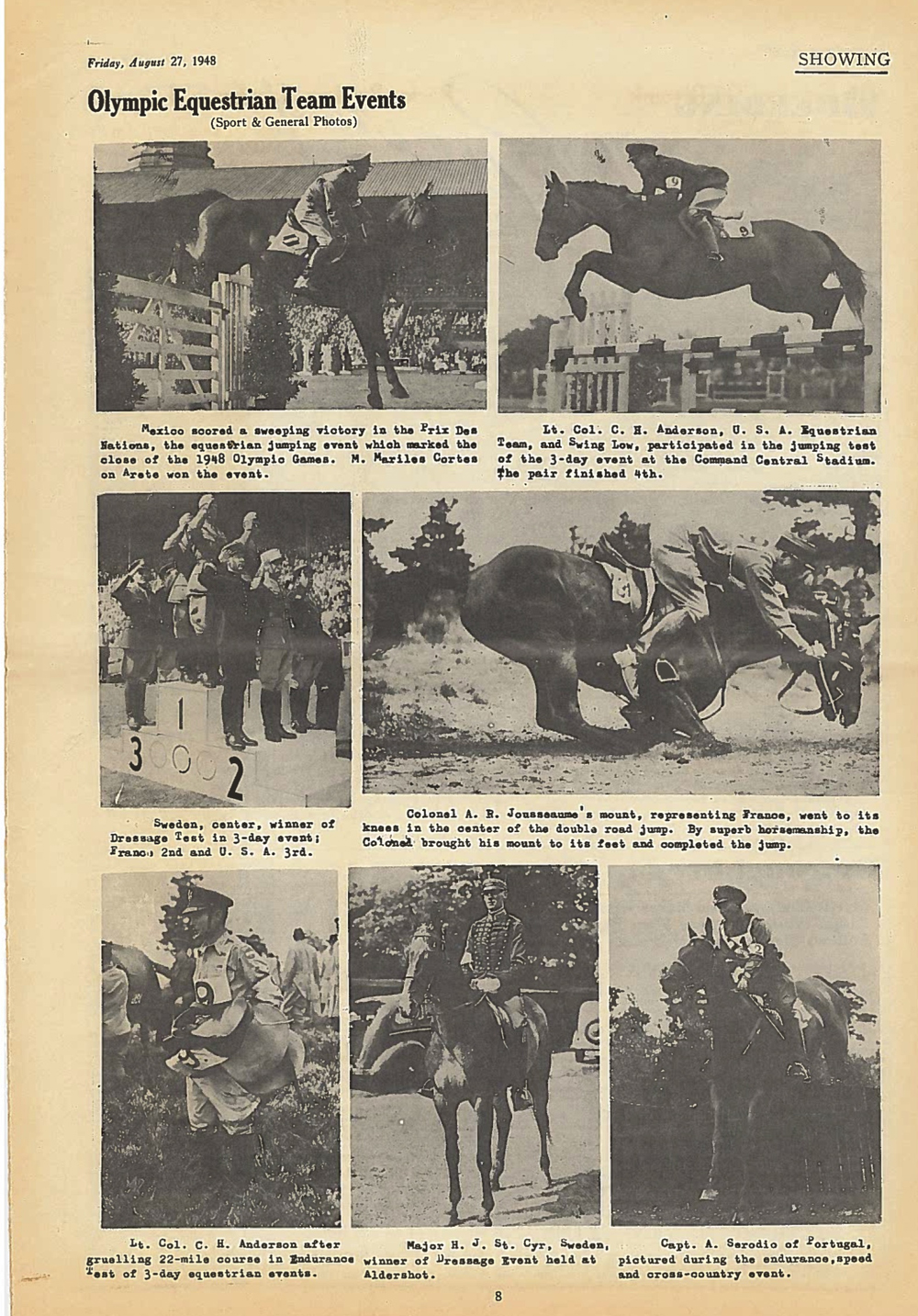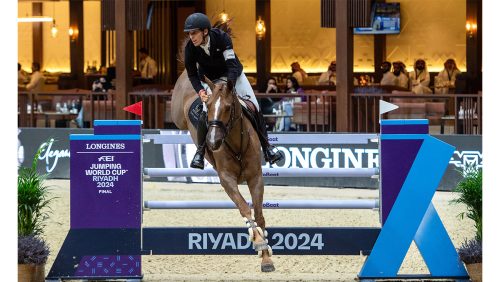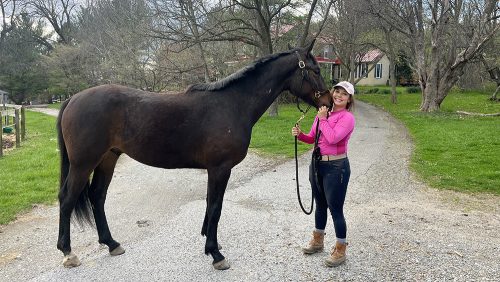The U.S. show jumping team for the 1948 Olympic Games was the last military Olympic team fielded. Col. Frank Wing rode the famous U.S. team mount Democrat, Capt. John Russell rode Air Mail, and Col. Andrew Frierson rode Rascal.
The National Sporting Library and Museum unearthed some amazing video of the team training for the Games…
United States Olympic Riders 1948 from NSLM on Vimeo.
The Jan. 16, 1948, issue of the Chronicle included this introduction to the team’s horses:
The horses that our Olympic Equestrian Team will ride in the 1948 Games are not super horses.
On the contrary, they are, for the most part, half Thoroughbred or better. They are the result of careful selection from the U.S. Remount breeding and purchasing program. After they have shown an above-average aptitude for jumping they were turned over to the Army Equestrian team for intensified training.
The results are very gratifying, when we realize that the average price the U.S. Remount was permitted to pay for these horses was $165 a head. Some countries pay $10,000 to $30,000 for horses they think will win the Olympics for them.
One of the most experienced horses on the team will be the 14-year-old “Democrat,” a Thoroughbred gelding by Gordon Russell out of Princess Bon. He was on the three-day event team in 1940. Since the team was reformed in 1946, Colonel Franklin F. Wing, Jr., has shown him in international competition at Madison Square Garden and at the Royal Winter Fair in Toronto. Democrat is the type that will always be in the money no matter which way the team decides to use him.
ADVERTISEMENT
“Airmail” is a 17-year-old half Thoroughbred bay gelding by Aeromail. He has been a consistent performer in local shows around Ft. Riley. Last year he was taken to Madison Square Garden for the first time in international competition. Ably ridden by Colonel Franklin F. Wing, Jr., Airmail placed second in the team of two and third in the Bowman Challenge Cup.
“Rascal,” bay gelding, 16 hands, 17 years old, Breeding unknown. Rascal was captured with German Team horses at Bayreuth. He appeared in New York and Toronto ridden by Colonel Earl F. Thomson to win one first, three seconds and two thirds.
“Totilla,” brown gelding, 14 years old, 16.2 hands. Breeding unknown. He was captured near Hamburg, Germany by the 2nd Cavalry Group. Totilla was formerly on the German Equestrian Team.

It was a much different time, with World War II having just ended. The team contenders shipped to Europe months before the Games in August. In the March 19, 1948, issue of the Chronicle there was this recounting of the team’s travels:
As many of you know, we have our team in Europe right now. The decision to ship them in the late fall was based on several points, all of them demanding an early shipment.
First of all, the good old days of phoning the ship’s broker and getting passage on properly equipped ships have not returned. Proper shipment is extremely expensive and ships are scarce.
Secondly, shipping in the late winter or early spring invites trouble on the North Atlantic. Your best horse is always the one to get hurt. Spring shipment would be too late, as the horses might not get back into condition, particularly the three-day horses.
Perhaps the deciding factor was our desire to get the team settled in Europe and in condition to get some Continental competition before the Games. Unfortunately, the competition available in this country is not the type needed. We work under a different set of rules and the courses are quite dissimilar.
ADVERTISEMENT
In all, ten officers, including the veterinarian, Lt. Colonel Harvie Ellis, eleven enlisted men, and thirty-one horses made the trip. In addition to Colonel E.F. Thomson, Team Captain, Colonel A.A. Frierson, Colonel F.F. Wing, Lt. Cols. F. S. Henry, C.A. Symroski, C.A. Anderson, Capts. J.W. Russell, J.R. Burton and Lieutenant R.J. Borg are the other riders on the team.
A recent letter from Colonel Thomson indicates that they are nicely settled. They are working at the Munich-Reims racetrack—adjacent to the Munich Airport. To quote from his letter: “Training facilities at the Munich-Reims racetrack are very complete, there are adequate stables, a riding hall, schooling areas, a hippodrome, racetracks and steeplechase courses.”
To indicate this is a pretty good place, let me say that the S.S. people used it as their horse training center during the war. They were a crowd who did not hesitate to take the best and improve it here and there.
Depending on the policy of the theatre commander, the team will probably have an opportunity to compete in a number of Continental horse shows. If the theatre commander can see his way clear to allow the team to compete, it will do much towards their effectiveness in London. They will meet and learn to know all the horses and riders they will run into in the Games.
They will find their weaknesses and their strength. Let us hope the latter outweighs the former. At any rate, all has been done that can be done for the Olympic effort. It is now in the hands of the gods, the lap of lady luck, and under the guidance of the European Commander’s policy.
The 1948 U.S. Olympic show jumping team ended up eliminated from the Games, but the dressage team of Lt. Robert Borg on Klingson, Col. Earl Thomson on Pancraft and Lt. Col. Frank Henry on Reno Overdo took team silver, and the three-day eventing team of Lt. Col. Frank Henry on Swing Low, Lt. Col. Charles Anderson on Reno Palisades and Col. Earl Thomson on Reno Rhythm won gold.
















